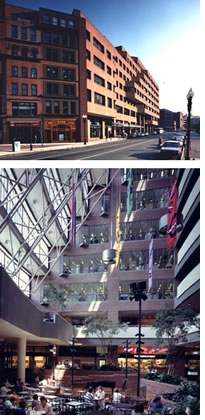

Boston’s Goody Clancy brings out the best of both
by Sara
Malone
Professional Practice editor/writer
Applying sustainable design technology to historic buildings necessitates a delicate balancing act. “We must bridge sustainability and preservation,” said Jean Carroon, AIA, principal and director of preservation at Boston’s Goody Clancy.
Carroon, who has considerable practical experience in environmentally sensitive design, shared her insights on how this balancing exercise works during a January 27 lecture at the National Building Museum in Washington, D.C.
“There is little overlap right now,” she said. “Too often architects will do a gut rehab simply to improve the energy numbers.” Architects have a lot to learn from each other on the merger of sustainability and preservation, especially in its early stage. “We could easily have common goals,” she added.
 Diverse
applications
Diverse
applications
Preservation work is varied—encompassing anything from boats to
landscapes—thus there is no set way to approach projects, Carroon
explained. Sometimes the project interior is as important as the exterior,
and a gut rehab is not always the answer. “Historic buildings are
about change,” she said. “They are not frozen. Good preservation
is about managing the change. It is okay to include things like low-light
and LED signs. But, at the same time, we’ve become too spoiled and
expect things, like air conditioning, that can damage old interiors and
materials.”
When tackling a project, you must ask yourself what opportunities are manifesting, Carroon said. For instance, Goody Clancy designed Boston’s Massachusetts Transportation Building, woven into the existing fabric of the city’s theater district, to operate without a furnace, conventional fuel, or back-up heating system. Instead, the building captures heat from 2,000 employees, lights, computers, and other equipment and stores it in three 250,000-gallon concrete water-storage tanks. Additionally, 4,000 square feet of solar collectors provide 82 percent of the building’s hot water needs. During the summer, the tanks store chilled water produced at off-peak electric rates for use during peak cooling periods. The Boston Society of Architects awarded the project its Excellence in Sustainability Design Award in 1989.
Finding distinctive features
For the renovation of the McCormick Building, also in Boston, Carroon
is examining the building to determine if it possesses unusual features
that can be used in a new way. In this case, the answer may lie in a below-ground
concrete slab. Although the architect is still exploring using the slab
to cool the building, so far the project engineers and consultants haven’t
come up with any practical way to do so. This building also has a “moat”
under the sidewalk that has caught Carroon’s attention. The question
again is: What do you do with it?
Additionally, preservation involves choosing which elements to save from a historic standpoint. For example, you don’t want to lose historic spaces, so you might have to give up some less significant space on other floors to accommodate modern uses. For instance, the McCormick Building’s old corridors are original elements, yet saving them would have raised complicated fire and seismic concerns. “There will always be trade-offs, so you have to prioritize what’s most important,” Carroon said. “To save the building you often have to recycle some of the lesser pieces of the fabric. Also, the building still has to work for the landlord.”
Leading with LEED™
Goody Clancy has also implemented sustainability strategies that support
each other, such as condensate recovery and gray-water systems. The firm
is currently pursuing a grant to test using titanium dioxide on the interior
side of glass to purify indoor air.
The firm uses the U.S. Green Building Council’s Leadership in Energy & Environmental Design (LEED™) system. Although detractors dismiss the program as simply a “checklist,” Carroon believes it pushes people to realize that environmental design goes beyond energy to the bigger picture. It is her personal mission to work with USGBC to make LEED™ more preservation friendly. “Maybe one day it will also include historic buildings,” she said.
“There’s not just one side; it’s not just historic fabric or just energy concerns. This would not be logical,” Carroon concluded. “There is no right or wrong—we must strike a balance, because really they are complementary.”
Copyright 2003 The American Institute of Architects.
All rights reserved. Home Page ![]()
![]()
 |
||
| Pictured
here is the award-winning and energy-efficient Massachusetts Transportation
Building (from the architect's Web site). |
||